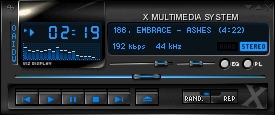XMMS
 |
|
| Developer(s) | XMMS Team |
|---|---|
| Initial release | November 1997 |
| Stable release | 1.2.11 (November 16, 2007) |
| Preview release | none (none) |
| Repository | no%20value |
| Development status | Discontinued |
| Written in | C, C++ (GTK+ 1.x) |
| Operating system | Unix-like |
| Type | Audio player |
| License | GNU General Public License |
| Website | legacy |
X Multimedia System (XMMS) is an audio player for Unix-like systems released under a free software license.
XMMS was originally written as X11Amp by Peter and Mikael Alm in November 1997. The player was made to resemble Winamp, which was first released in May that year. As such, XMMS has supported Winamp 2 "classic" skins since its release. Though the original release was made under a license that did not provide any access to the program's source code, it is now released under the GNU General Public License.
On June 10, 1999, 4Front Technologies decided to sponsor X11Amp development and the project was renamed to XMMS - the name being an acronym for X MultiMedia System. Most XMMS users take this to mean "X11 MultiMedia System" or "X Window System MultiMedia System"; the official interpretation of the "X" is "Cross-platform".
In 2002, Peter Alm initiated the XMMS2 project, aiming to produce a successor to XMMS using all new code and devoted solely to audio playback.
XMMS has continued to use GTK+ 1.x toolkit, despite a major revision of GTK (2.x) being available for several years, and the current version being GTK3. The primary reason for this reluctance to upgrade is that many XMMS plugins (written by third parties) are dependent on the older version of GTK+ to properly function, e.g., "about" boxes and configuration dialogs. Many software developers also consider the XMMS codebase to be poorly designed and difficult to maintain. These factors led to various forks and related projects:
XMMS currently supports the following audio and video file formats:
XMMS has a default skin provided, but it is also possible to use any WSZ classic skins to enhance the graphic attractiveness of the player. (see attached image)
...
Wikipedia
